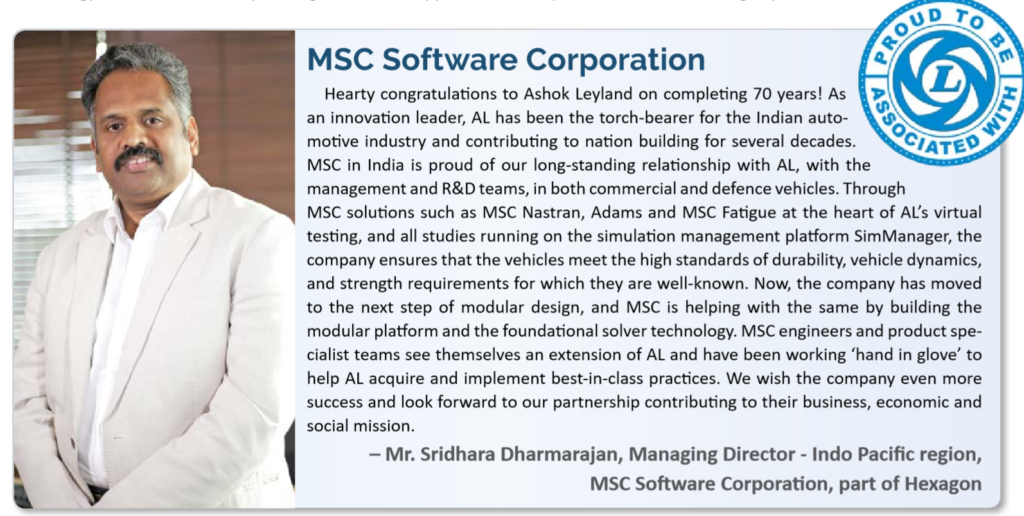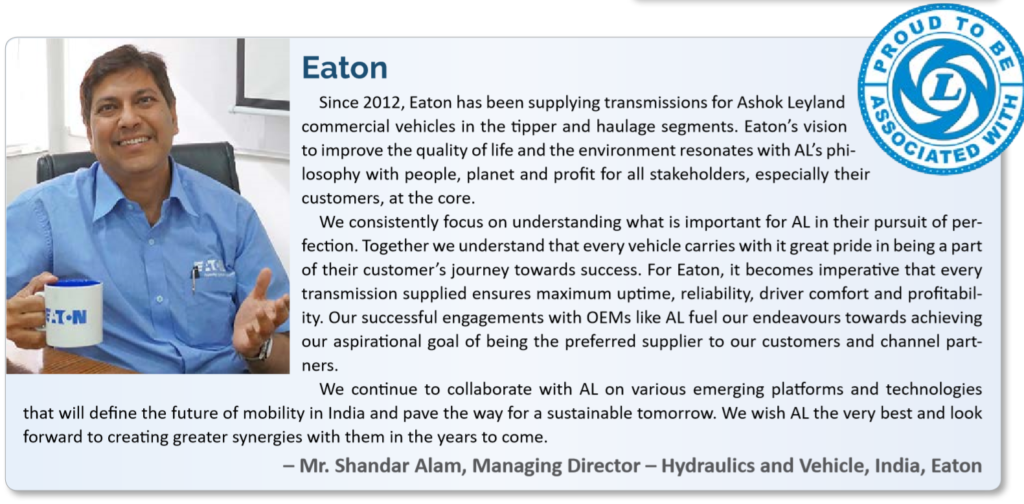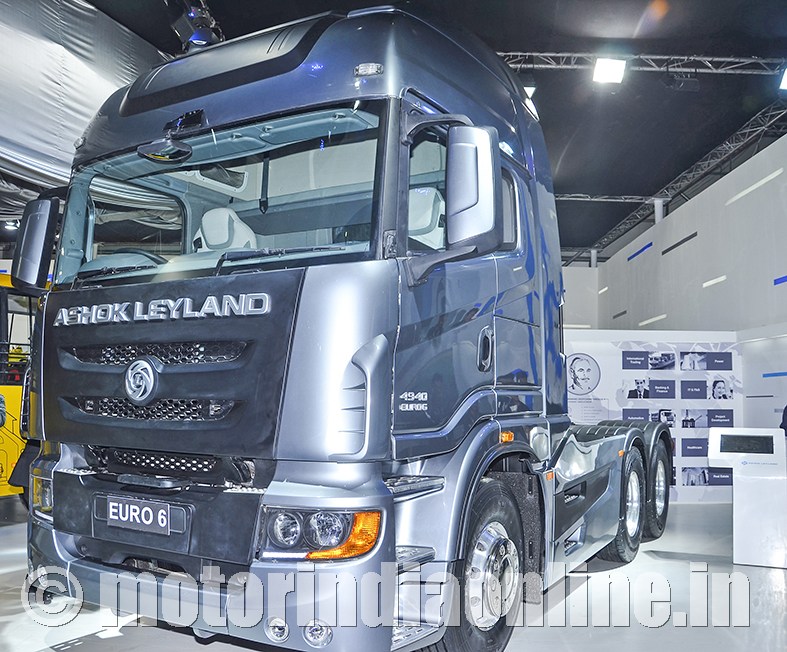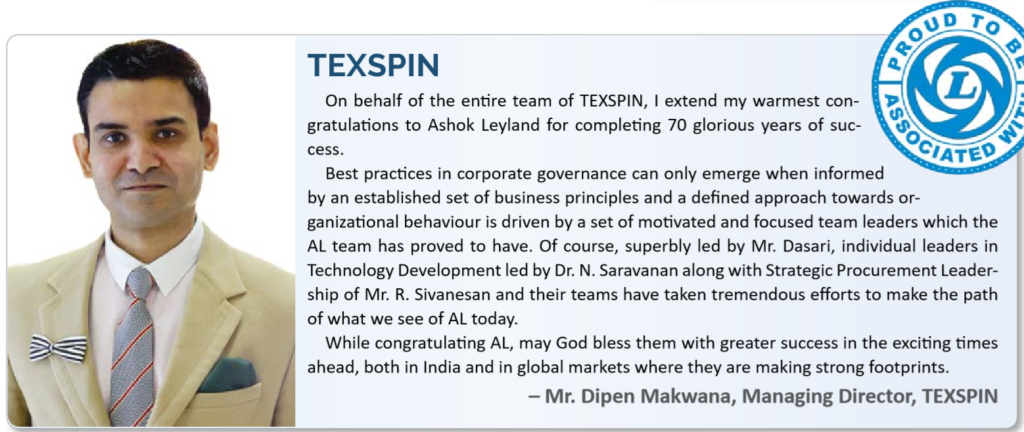“You will see with BS-VI, various AL platforms merging and becoming a more holistic modular platform. On the trucks front, in terms of modularity it will be more challenging because we have multiple suppliers to deal with, and if the market drives for much more customised products and variants faster, the only approach to do it is the modular way,” says Dr. N. Saravanan, Head – Engineering Product Development, Ashok Leyland Ltd. (AL) Technical Centre.
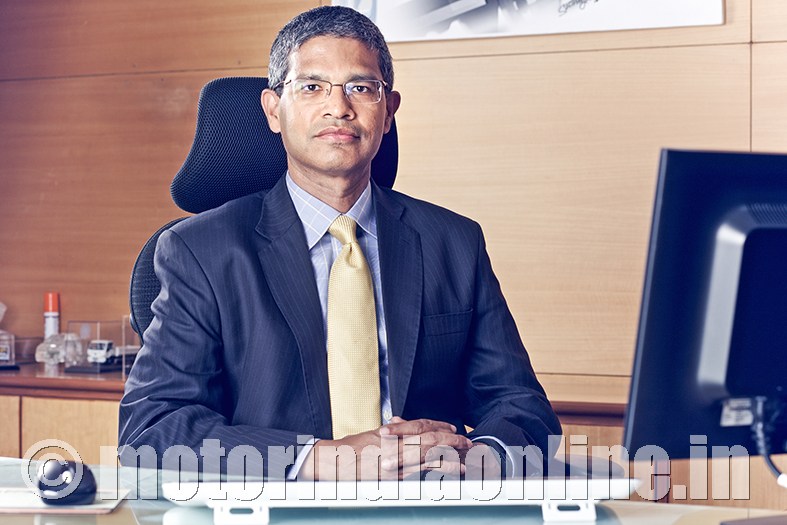
Excerpts:
Can you brief the Product Development group’s contribution and growth during AL’s 70 years traverse path? Highlight also the key current projects and the direction of future operations.
I can share my observations of the last 12 years I have spent in AL. During this period, product development and engineering group have seen a significant growth. AL actually got split from Iveco which was a part of it and became an independent firm, to being one of the few CV manufacturers with no foreign collaboration or formal partnership.
It made us look at the entire product strategy and invest in people with various skill sets; and the above backed by investments has led to rapid growth. From one building, a few hundred people and a small design office, we have expanded to this level of about 1,500 engineers and various advanced facilities in the last 12 years, and that is a fantastic achievement.
For the ‘next 5 years’, multiple big efforts are going on. One is looking at the entire portfolio of BS-VI vehicles. This means complete redesign of engine platforms and using the opportunities to look at making our vehicles more modular. The other aspect of course is looking at the key segments in electrification of vehicles evolving rapidly, starting with intra-city bus.
Within the subset of the above, various projects have been visualized for the next 3 to 5 years. We also have other products lined up for the domestic and export markets, but the above indicated are undoubtedly the two key areas to set the direction and drive the market strategy.
Tell us about the design set-up and approach for new products development. Also, can you share the strategy and details behind the development of 41 ton GVW 5-axle rigid truck perceived to be encroaching on the tractor-trailer space?
Tech centre is a business unit, and we have a horizontal structure to support not only M&HCV trucks and buses but also LCV, Defense, Power solutions and all other business units. We look at development as down to the systems, viz., groups involved in the development of various systems such as engine, gearbox, chassis, etc.
All come together during vehicle integration, and we call that group as vehicle engineering group. The projects addressed by PD essentially fall under three categories. Category A is a large platform where teams work cross functionally and all the team members are involved. Electric vehicle is in this category. Lowest C category could be an assignment minor in nature, say for a change from cross-ply tyre to tubeless radial.
This could involve checks for interference, fuel impact, load testing and homologation. Typically lots of B category projects are addressed and this can touch 3 or 4 systems and those connected with that work together.
As regards the higher GVW rigid chassis, they are introduced based on our thinking of likely developments. After the 37 ton GVW 5-axle truck, we are now positioning 41 ton GVW, 5-axle truck based on our market observation of developments in the hub and spoke model. Tractor-trailer has some constraints vis-à-vis availability of drivers, special licensing and flexibility in operations.
The 41 ton is a sweet spot wherein you have the right trade-off between the vehicle length and the number of areas it serves. In increasing the GVW from 37 to 41 ton, unladen weight increase is less than 500 kg and most of 4 ton increase has been provided for payload. The same is achieved by strengthening the axles and tyres.
Apprise us about the LCV segment developments in which AL had made a late entry, and also about the thrust to fully built bus (FBB) program against the backdrop of the Bus Code changes, importance to safety and exports.
LCV DOST is one of the successful products launched in AL portfolios. M&HCV is typically a high mix low volume business with a single variant not more than 10,000 vehicles per annum. On the other hand, LCV offers big numbers and our focus area is going to be on the 2.5 ton to 5 ton GVW range where impressive market exists both on the domestic and export fronts.
LCVs are also subject to cost pressures and performance & reliability expectations close to the passenger cars. We are not interested in the sub-2.5 ton GVW as the competition herein is stiff and it’s a high volume low margin segment. With BS-VI in 2020, on the new platform you will see much wider distribution of our product range for the customer applications.
The Bus Body Code introduced and applicable in its current format is definitely not favouring OEMs in their endeavour to supply FBB meeting all safety norms. If the customer comes to AL, the specs will be different to meet the Bus Code and all of it inflates the price to him.
On the other hand if he goes to the body builder taking only the chassis from us, the body building costs are going to be lower with the self certification by the body builder. Only emission needs to meet the norms and on NVH, acceleration, fire protection code and multiplexing from electrical aspects, conformities are not required; hence the divide in the segment will only widen and regulations not driving operational safety.
On the exports front, we are looking at specific applications in the African and Gulf markets. We have a tech centre at the RAK plant in the UAE with a team of engineers engaged in customizing the buses for specific markets in the region. We also supply chassis kits and aggregates to other countries for subsequent body building there as per agreement.
BS-VI is expected to pose challenges to all players in the domain. Kindly give us more details from the PD perspective and the other technology-driven systems in your purview for market introduction.
BS-VI transition is definitely challenging, and there are no issues in AL meeting the targets of performance and the time limit. The real challenges are going to be in the technical capabilities of highway and dealer mechanics to handle the vehicle problems. Electronics will more than double with the same linked to emissions, and if anything goes wrong, the performance will be significantly affected.
Short term training or certification of the mechanics is not going to help in the technology shift, and realistically looking, CV service support could become like that in cars – customers approaching OEM’s service facilities for attending to their problems. As regards technology-related developments, ADAS (Advanced driver assist systems) for collision warning, avoidance, driver behavior monitoring and other advisory measures for correction are on the cards.
We also provide roll-over compliance in all our buses as a company policy though the same are mandatory only in some select segments.
Comment on the trends in electrification of vehicles and the projects PD is working on to address the evolving market requirements.
We are working on electrification of buses and LCVs in the first phase. We are not looking at products that will survive only with subsidies. Our focus hence is on combinations of battery architecture, swapping, and flash charging and integrating components. Battery is the biggest cost driver and it’s an ongoing game indulged in by domain players putting various models in the market to gain experience and understand what will work best.
In my opinion we have not even taken the first steps. OEMs will take about 5 years to get to a point of understanding, develop the feel and what makes sense for the applications. For EV, domain skill sets have to be totally different, and in the absence of ready availability we plan to hire people with basic skills and train them to meet the capabilities.
We cannot compete with Chinese players for lower cost of batteries, but looking at the option of swapping smartly. ICE took about 40 years to stabilize, and it may take about 10 years for the EV space to reach that level and provide a level playing field for the competing players.
